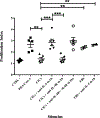Cancer-initiating cells from colorectal cancer patients escape from T cell-mediated immunosurveillance in vitro through membrane-bound IL-4
- PMID: 24277698
- PMCID: PMC8744948
- DOI: 10.4049/jimmunol.1301342
Cancer-initiating cells from colorectal cancer patients escape from T cell-mediated immunosurveillance in vitro through membrane-bound IL-4
Abstract
Cancer-initiating cells (CICs) that are responsible for tumor initiation, propagation, and resistance to standard therapies have been isolated from human solid tumors, including colorectal cancer (CRC). The aim of this study was to obtain an immunological profile of CRC-derived CICs and to identify CIC-associated target molecules for T cell immunotherapy. We have isolated cells with CIC properties along with their putative non-CIC autologous counterparts from human primary CRC tissues. These CICs have been shown to display "tumor-initiating/stemness" properties, including the expression of CIC-associated markers (e.g., CD44, CD24, ALDH-1, EpCAM, Lgr5), multipotency, and tumorigenicity following injection in immunodeficient mice. The immune profile of these cells was assessed by phenotype analysis and by in vitro stimulation of PBMCs with CICs as a source of Ags. CICs, compared with non-CIC counterparts, showed weak immunogenicity. This feature correlated with the expression of high levels of immunomodulatory molecules, such as IL-4, and with CIC-mediated inhibitory activity for anti-tumor T cell responses. CIC-associated IL-4 was found to be responsible for this negative function, which requires cell-to-cell contact with T lymphocytes and which is impaired by blocking IL-4 signaling. In addition, the CRC-associated Ag COA-1 was found to be expressed by CICs and to represent, in an autologous setting, a target molecule for anti-tumor T cells. Our study provides relevant information that may contribute to designing new immunotherapy protocols to target CICs in CRC patients.
Conflict of interest statement
Disclosures
The authors have no financial conflicts of interest.
Figures




References
-
- Clevers H 2011. The cancer stem cell: premises, promises and challenges. Nat. Med. 17: 313–319. - PubMed
-
- Ricci-Vitiani L, Fabrizi E, Palio E, and De Maria R. 2009. Colon cancer stem cells. J. Mol. Med. 87: 1097–1104. - PubMed
-
- Bao S, Wu Q, McLendon RE, Hao Y, Shi Q, Hjelmeland AB, Dewhirst MW, Bigner DD, and Rich JN. 2006. Glioma stem cells promote radioresistance by preferential activation of the DNA damage response. Nature 444: 756–760. - PubMed
-
- Eramo A, Ricci-Vitiani L, Zeuner A, Pallini R, Lotti F, Sette G, Pilozzi E, Larocca LM, Peschle C, and De Maria R. 2006. Chemotherapy resistance of glioblastoma stem cells. Cell Death Differ. 13: 1238–1241. - PubMed
Publication types
MeSH terms
Substances
Grants and funding
LinkOut - more resources
Full Text Sources
Other Literature Sources
Medical
Miscellaneous

